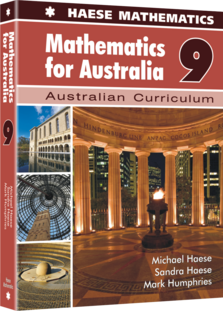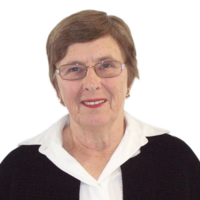About the Book
Year Published: 2012
Page Count: 502
ISBN: 978-1-921972-03-4 (9781921972034)
Online ISBN: 978-1-921972-88-1 (9781921972881)

Discontinued Editions - digital subscriptions remain available
Year Published: 2012
Page Count: 502
ISBN: 978-1-921972-03-4 (9781921972034)
Online ISBN: 978-1-921972-88-1 (9781921972881)
| 1 | ALGEBRA | 9 | |
| A | Algebraic notation | 10 | |
| B | Algebraic expressions | 12 | |
| C | Evaluating algebraic expressions | 13 | |
| D | Collecting like terms | 15 | |
| E | Algebraic products | 16 | |
| F | Algebraic fractions | 17 | |
| Review set 1 | 22 | ||
| Practice test 1A - Multiple choice | CD | ||
| Practice test 1B - Short response | 23 | ||
| Practice test 1C - Extended response | 23 | ||
| 2 | INDICES | 25 | |
| A | Evaluating indices | 26 | |
| B | Index laws | 29 | |
| C | Scientific notation | 35 | |
| D | Significant figures | 39 | |
| Review set 2 | 40 | ||
| Practice test 2A - Multiple choice | CD | ||
| Practice test 2B - Short response | 41 | ||
| Practice test 2C - Extended response | 42 | ||
| 3 | PERCENTAGE | 43 | |
| A | Percentage | 44 | |
| B | Expressing one quantity as a percentage of another | 46 | |
| C | Finding a percentage of a quantity | 47 | |
| D | The unitary method in percentage | 48 | |
| E | Percentage increase and decrease | 50 | |
| F | Finding the original amount | 53 | |
| G | Simple interest | 54 | |
| H | Compound interest (Extension) | 58 | |
| Review set 3 | 61 | ||
| Practice test 3A - Multiple choice | CD | ||
| Practice test 3B - Short response | 62 | ||
| Practice test 3C - Extended response | 63 | ||
| 4 | SETS AND VENN DIAGRAMS | 65 | |
| A | Sets | 66 | |
| B | Special number sets | 68 | |
| C | Set builder notation | 69 | |
| D | Complement of a set | 71 | |
| E | Venn diagrams | 73 | |
| F | Problem solving with Venn diagrams | 80 | |
| Review set 4 | 83 | ||
| Practice test 4A - Multiple choice | CD | ||
| Practice test 4B - Short response | 84 | ||
| Practice test 4C - Extended response | 85 | ||
| 5 | ALGEBRAIC EXPANSION AND SIMPLIFICATION | 87 | |
| A | The distributive law | 88 | |
| B | The product (a + b)(c + d) | 90 | |
| C | Difference of two squares | 92 | |
| D | Perfect squares expansion | 94 | |
| E | Further expansion | 96 | |
| F | The binomial expansion | 98 | |
| Review set 5 | 99 | ||
| Practice test 5A - Multiple choice | CD | ||
| Practice test 5B - Short response | 99 | ||
| Practice test 5C - Extended response | 100 | ||
| 6 | INTERPRETING TABLES AND GRAPHS | 101 | |
| A | Interpreting tables | 102 | |
| B | Interpreting graphs | 107 | |
| C | Line graphs | 111 | |
| D | Travel graphs | 113 | |
| Review set 6 | 117 | ||
| Practice test 6A - Multiple choice | CD | ||
| Practice test 6B - Short response | 119 | ||
| Practice test 6C - Extended response | 123 | ||
| 7 | LINEAR EQUATIONS | 125 | |
| A | Linear equations | 126 | |
| B | Rational equations | 129 | |
| C | Problem solving | 132 | |
| D | Mixture problems | 137 | |
| Review set 7 | 138 | ||
| Practice test 7A - Multiple choice | CD | ||
| Practice test 7B - Short response | 139 | ||
| Practice test 7C - Extended response | 140 | ||
| 8 | RADICALS AND PYTHAGORAS | 141 | |
| A | Square roots | 142 | |
| B | Rules for square roots | 144 | |
| C | Solving x² = k | 146 | |
| D | Pythagoras' theorem | 148 | |
| E | The converse of Pythagoras' theorem | 153 | |
| F | Pythagorean triples | 155 | |
| G | Problem solving using Pythagoras | 158 | |
| H | Cube roots | 161 | |
| Review set 8 | 163 | ||
| Practice test 8A - Multiple choice | CD | ||
| Practice test 8B - Short response | 164 | ||
| Practice test 8C - Extended response | 165 | ||
| 9 | LENGTH AND AREA | 167 | |
| A | Length | 168 | |
| B | Perimeter | 170 | |
| C | Area | 174 | |
| D | Area formulae | 176 | |
| E | Areas of composite figures | 183 | |
| Review set 9 | 188 | ||
| Practice test 9A - Multiple choice | CD | ||
| Practice test 9B - Short response | 190 | ||
| Practice test 9C - Extended response | 191 | ||
| 10 | COORDINATE GEOMETRY | 193 | |
| A | The distance between two points | 195 | |
| B | Midpoints | 198 | |
| C | Gradient | 200 | |
| D | Axes intercepts | 206 | |
| E | The equation of a line | 207 | |
| F | Graphing lines from equations | 209 | |
| G | Vertical and horizontal lines | 212 | |
| H | Finding the equation of a line | 212 | |
| Review set 10 | 216 | ||
| Practice test 10A - Multiple choice | CD | ||
| Practice test 10B - Short response | 217 | ||
| Practice test 10C - Extended response | 218 | ||
| 11 | FURTHER MEASUREMENT | 219 | |
| A | Solids | 220 | |
| B | Surface area | 222 | |
| C | Volume | 228 | |
| D | Capacity | 234 | |
| E | Time | 237 | |
| Review set 11 | 246 | ||
| Practice test 11A - Multiple choice | CD | ||
| Practice test 11B - Short response | 247 | ||
| Practice test 11C - Extended response | 248 | ||
| 12 | ALGEBRAIC FACTORISATION | 249 | |
| A | Common factors | 250 | |
| B | Factorising with common factors | 252 | |
| C | Difference of two squares factorising | 255 | |
| D | Perfect square factorisation | 257 | |
| E | Factorising quadratic trinomials | 259 | |
| F | Miscellaneous factorisation | 261 | |
| Review set 12 | 263 | ||
| Practice test 12A - Multiple choice | CD | ||
| Practice test 12B - Short response | 263 | ||
| Practice test 12C - Extended response | 264 | ||
| 13 | FORMULAE | 265 | |
| A | Formula construction | 266 | |
| B | Substituting into formulae | 268 | |
| C | Rearranging formulae | 271 | |
| D | Rearrangement and substitution | 273 | |
| Review set 13 | 275 | ||
| Practice test 13A - Multiple choice | CD | ||
| Practice test 13B - Short response | 276 | ||
| Practice test 13C - Extended response | 277 | ||
| 14 | STATISTICS | 279 | |
| A | Types of data | 281 | |
| B | Discrete numerical data | 282 | |
| C | Continuous numerical data | 287 | |
| D | Measuring the centre of a data set | 289 | |
| E | Measuring the spread of a data set | 296 | |
| F | Comparing numerical data | 299 | |
| G | Data collection | 303 | |
| Review set 14 | 307 | ||
| Practice test 14A - Multiple choice | CD | ||
| Practice test 14B - Short response | 308 | ||
| Practice test 14C - Extended response | 309 | ||
| 15 | PROBABILITY | 311 | |
| A | Experimental probability | 313 | |
| B | Probabilities from tabled data | 314 | |
| C | Life tables | 317 | |
| D | Sample space | 319 | |
| E | Theoretical probability | 321 | |
| F | Using 2-dimensional grids | 323 | |
| G | Compound events | 325 | |
| H | Using tree diagrams | 328 | |
| I | Sampling with and without replacement | 332 | |
| J | Probabilities from Venn diagrams | 334 | |
| Review set 15 | 337 | ||
| Practice test 15A - Multiple choice | CD | ||
| Practice test 15B - Short response | 338 | ||
| Practice test 15C - Extended response | 339 | ||
| 16 | SIMILARITY AND CONGRUENCE | 341 | |
| A | Enlargements and reductions | 344 | |
| B | Similar figures | 346 | |
| C | Similar triangles | 349 | |
| D | Problem solving | 353 | |
| E | Areas of similar objects | 357 | |
| F | Volumes of similar objects | 359 | |
| G | Congruent triangles | 361 | |
| Review set 16 | 367 | ||
| Practice test 16A - Multiple choice | CD | ||
| Practice test 16B - Short response | 368 | ||
| Practice test 16C - Extended response | 370 | ||
| 17 | TRIGONOMETRY | 371 | |
| A | Labelling right angled triangles | 372 | |
| B | The trigonometric ratios | 373 | |
| C | Finding side lengths | 377 | |
| D | Finding angles | 378 | |
| E | Problem solving with trigonometry | 380 | |
| Review set 17 | 385 | ||
| Practice test 17A - Multiple choice | CD | ||
| Practice test 17B - Short response | 386 | ||
| Practice test 17C - Extended response | 387 | ||
| 18 | SIMULTANEOUS EQUATIONS | 389 | |
| A | Trial and error solution | 391 | |
| B | Graphical solution | 392 | |
| C | Solution by equating values of y | 393 | |
| D | Solution by substitution | 394 | |
| E | Solution by elimination | 395 | |
| F | Problem solving with simultaneous equations | 398 | |
| Review set 18 | 401 | ||
| Practice test 18A - Multiple choice | CD | ||
| Practice test 18B - Short response | 401 | ||
| Practice test 18C - Extended response | 402 | ||
| 19 | PROPORTION | 403 | |
| A | Direct proportion | 404 | |
| B | Other direct proportions | 408 | |
| C | Inverse proportion | 412 | |
| Review set 19 | 416 | ||
| Practice test 19A - Multiple choice | CD | ||
| Practice test 19B - Short response | 417 | ||
| Practice test 19C - Extended response | 418 | ||
| 20 | QUADRATIC EQUATIONS | 419 | |
| A | Quadratic equations | 420 | |
| B | The Null Factor law | 421 | |
| C | Solving quadratic equations | 422 | |
| D | Problem solving with quadratic equations | 426 | |
| Review set 20 | 432 | ||
| Practice test 20A - Multiple choice | CD | ||
| Practice test 20B - Short response | 433 | ||
| Practice test 20C - Extended response | 434 | ||
| 21 | NON-LINEAR GRAPHS | 435 | |
| A | Quadratic functions | 436 | |
| B | Axes intercepts | 442 | |
| C | Drawing quadratics from their axes intercepts | 444 | |
| D | Circles | 446 | |
| Review set 21 | 452 | ||
| Practice test 21A - Multiple choice | CD | ||
| Practice test 21B - Short response | 452 | ||
| Practice test 21C - Extended response | 453 | ||
| ANSWERS | 455 | ||
| INDEX | 500 | ||

Michael completed a Bachelor of Science at the University of Adelaide, majoring in Infection and Immunity, and Applied Mathematics. He studied laminar heat flow as part of his Honours in Applied Mathematics, and finished a PhD in high speed fluid flows in 2001. He has been the principal editor for Haese Mathematics since 2008.
What motivates you to write mathematics books?
My passion is for education as a whole, rather than just mathematics. In Australia I think it is too easy to take education for granted, because it is seen as a right but with too little appreciation for the responsibility that goes with it. But the more I travel to places where access to education is limited, the more I see children who treat it as a privilege, and the greater the difference it makes in their lives. But as far as mathematics goes, I grew up with mathematics textbooks in pieces on the kitchen table, and so I guess it continues a tradition.
What do you aim to achieve in writing?
I think a few things:
What interests you outside mathematics?
Lots of things! Horses, show jumping and course design, alpacas, badminton, running, art, history, faith, reading, hiking, photography ....

Sandra completed a Bachelor of Science at the University of Adelaide, majoring in Pure Mathematics and Statistics. She taught at Underdale High School and Westminster School before founding Haese and Harris Publications (now Haese Mathematics), together with husband Robert (Bob) and colleague Kim Harris.
What drew you to the field of mathematics?
I always found mathematics the easiest subject at school. I’m not sure why. I intended to study Chemistry at university, but found I didn’t enjoy it as much as I thought I would – so I came back to mathematics, and have been involved with it ever since.
What motivated you to switch from teaching to writing mathematics books?
Bob used to write notes for his class. Other teachers at the school used the notes, then teachers at other schools started asking for them. Eventually Bob said, “Well, I might as well start writing textbooks!”
Initially, I was proofreading. As the workload increased, I began editing as well as proofreading. It just gradually became a full-time job, between writing material, editing and proofreading it, and then distributing the books. These days, Michael does the editing and I do proofreading and audio.
How has the field of textbook publishing changed in the years since you started?
When we started, text was typed and worked solutions were handwritten. Bob would draw any graphics by hand.
We moved to typesetting, but writing a mathematics textbook with the printing tools available presented its own difficulties. For example, symbols had to be copied, cut and pasted by hand onto the original pages, which was very tedious and time-consuming! Fractions were also problematic: we would type a line containing all the numerators, and then a line underneath for all the denominators.
Now it’s all done by computers, which is very much easier, and quicker!
What interests you outside mathematics?
I own a few alpacas. I enjoy my garden - I don’t do much in it, but I enjoy it! I like listening to music; mainly classical, but I enjoy other genres as well.
I really love to travel. The scenery, the history of a place, its architecture, its art – all of those things fascinate me. As a result I also enjoy photography; I like taking pictures of the things I’ve seen and places I’ve experienced.

Mark has a Bachelor of Science (Honours), majoring in Pure Mathematics, and a Bachelor of Economics, both of which were completed at the University of Adelaide. He studied public key cryptography for his Honours in Pure Mathematics. He started with the company in 2006, and is currently the writing manager for Haese Mathematics.
What got you interested in mathematics? How did that lead to working at Haese Mathematics?
I have always enjoyed the structure and style of mathematics. It has a precision that I enjoy. I spend an inordinate amount of my leisure time reading about mathematics, in fact! To be fair, I tend to do more reading about the history of mathematics and how various mathematical and logic puzzles work, so it is somewhat different from what I do at work.
How did I end up at Haese Mathematics?
I was undertaking a PhD, and I realised that what I really wanted to do was put my knowledge to use. I wanted to pass on to others all this interesting stuff about mathematics. I emailed Haese Mathematics (Haese and Harris Publications as they were known back then), stating that I was interested in working for them. As it happened, their success with the first series of International Baccalaureate books meant that they were looking to hire more people at the time. I consider myself quite lucky!
What are some interesting things that you get to do at work?
On an everyday basis, it’s a challenge (but a fun one!) to devise interesting questions for the books. I want students to have questions that pique their curiosity and get them thinking about mathematics in a different way. I prefer to write questions that require students to demonstrate that they understand a concept, rather than relying on rote memorisation.
When a new or revised syllabus is released for a curriculum that we write for, a lot of work goes into devising a structure for the book that addresses the syllabus. The process of identifying what concepts need to be taught, organising those concepts into an order that makes sense from a teaching standpoint, and finally sourcing and writing the material that addresses those concepts is very involved – but so rewarding when you hold the finished product in your hands, straight from the printer.
What interests you outside mathematics?
Apart from the aforementioned recreational mathematics activities, I play a little guitar, and I enjoy playing badminton and basketball on a social level.
A complete electronic copy of the textbook, with interactive, animated, and/or printable extras.
Animated worked examples with step-by-step, voiced explanations.
Graphics Calculator Instructions
For Casio fx-9860G Plus, TI-84 Plus, and TI-nspire
This book offers SELF TUTOR for every worked example. On the electronic copy of the textbook, access SELF TUTOR by clicking anywhere on a worked example to hear a step-by-step explanation by a teacher. This is ideal for catch-up and revision, or for motivated students who want to do some independent study outside school hours.
Graphics calculator instructions for Casio fx-9860G Plus, TI-84 Plus, and TI-nspire are included with this textbook. The textbook will either have comprehensive instructions at the start of the book, specific instructions available from icons located throughout, or both. The extensive use of graphics calculators and computer packages throughout the book enables students to realise the importance, application, and appropriate use of technology.

This book is available on electronic devices through our Snowflake learning platform. This book includes 15 months of Snowflake access, featuring a complete electronic copy of the textbook.
Where relevant, Snowflake features include interactive geometry, graphing, and statistics software, demonstrations, games, spreadsheets, and a range of printable worksheets, tables, and diagrams. Teachers are provided with a quick and easy way to demonstrate concepts, and students can discover for themselves and re-visit when necessary.
Register your interest for information related to Haese Mathematics products